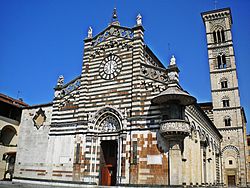Prato
| Prato | ||
|---|---|---|
| Comune | ||
| Comune di Prato | ||

The Cathedral of Prato
|
||
|
||
| Location of Prato in Italy | ||
| Coordinates: 43°52′48″N 11°05′54″E / 43.88000°N 11.09833°ECoordinates: 43°52′48″N 11°05′54″E / 43.88000°N 11.09833°E | ||
| Country | Italy | |
| Region | Tuscany | |
| Province / Metropolitan city | Prato (PO) | |
| Frazioni | See list | |
| Government | ||
| • Mayor | Matteo Biffoni | |
| Area | ||
| • Total | 97 km2 (37 sq mi) | |
| Elevation | 65 m (213 ft) | |
| Population (31 October 2015) | ||
| • Total | 191,104 | |
| • Density | 2,000/km2 (5,100/sq mi) | |
| Demonym(s) | Pratesi | |
| Time zone | CET (UTC+1) | |
| • Summer (DST) | CEST (UTC+2) | |
| Postal code | 59100 | |
| Dialing code | 0574 | |
| Patron saint | St. Stephen | |
| Saint day | December 26 | |
| Website | Official website | |
Prato (Italian pronunciation: [ˈpraːto]) is a city and comune in Tuscany, Italy, the capital of the Province of Prato. The city is at the foot of Monte Retaia, elevation 768 metres (2,520 ft), the last peak in the Calvana chain. The lowest elevation in the comune is 32 metres (105 ft), near the Cascine di Tavola, and the highest is the peak of Monte Cantagrillo at 818 metres (2,684 ft). The Bisenzio (river), a tributary of the Arno, flows through it.
Historically, Prato's economy has been based on the textile industry. The renowned Datini archives are a significant collection of late medieval documents concerning economic and trade history, produced between 1363 and 1410.
Prato is also a centre of the slow food movement, with many local specialities, including cantucci, a type of biscotti, sold by local speciality bakers.
Since the late 1950s, the city has experienced significant immigration, firstly from southern Italy, then from other nationalities, the most notable being a large Chinese community which first arrived in the late 1980s. With more than 191,000 inhabitants, Prato is Tuscany's second largest city and the third largest in Central Italy, after Rome and Florence.
Archaeological findings have proved that Prato's surrounding hills were inhabited since Paleolithic times. The plain was later colonized by the Etruscans. In 1998 remains of a previously unknown city from that civilization were discovered in the neighbourhood, at Gonfienti (Prato) near Campi Bisenzio: it was of medium size and it was already a centre for wool and textile industry. According to some scholars, it could be the mythical Camars. The Etruscan city was inhabited until the 5th century BC, when, for undisclosed reasons, it decayed; control of the area was later shifted to the Romans, who had their Via Cassia pass from here, but did not build any settlement.
...
Wikipedia


